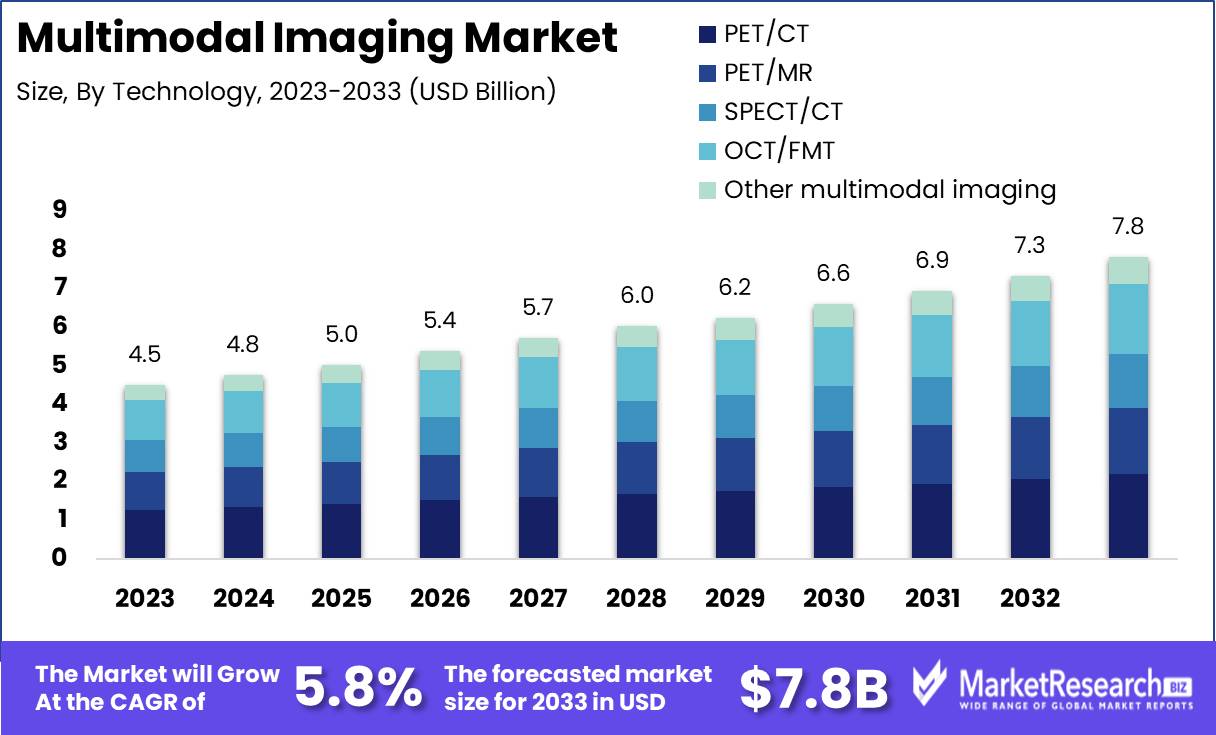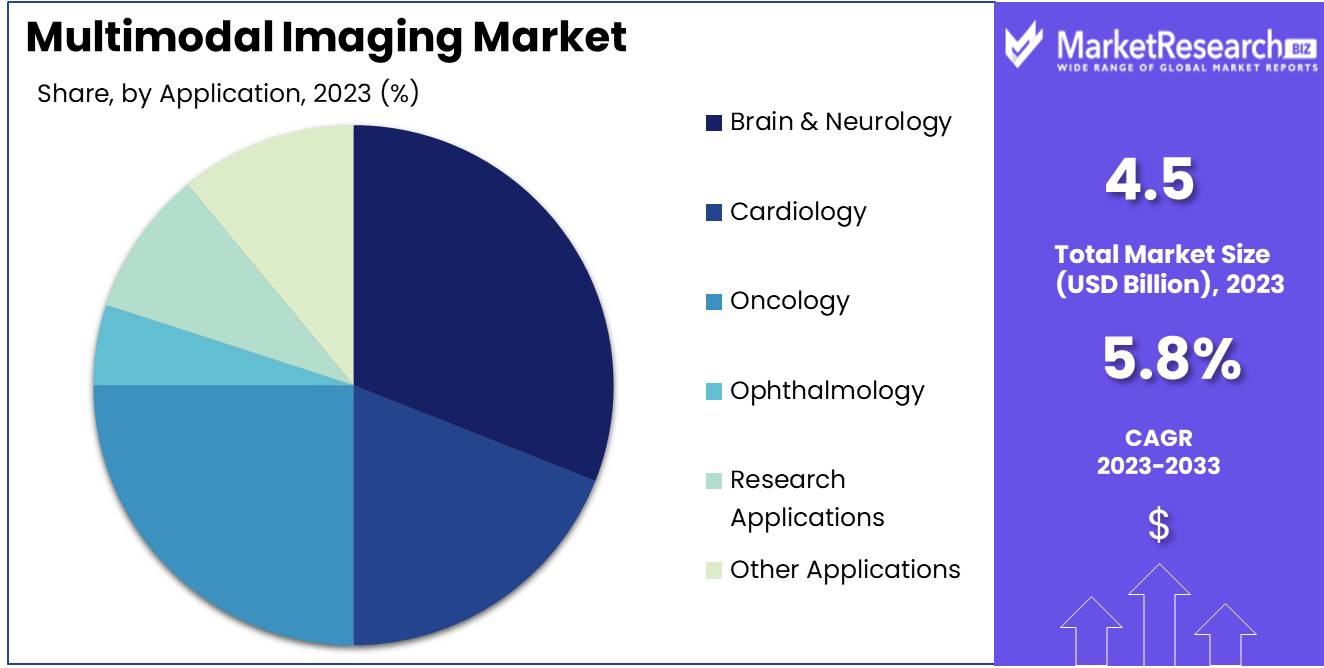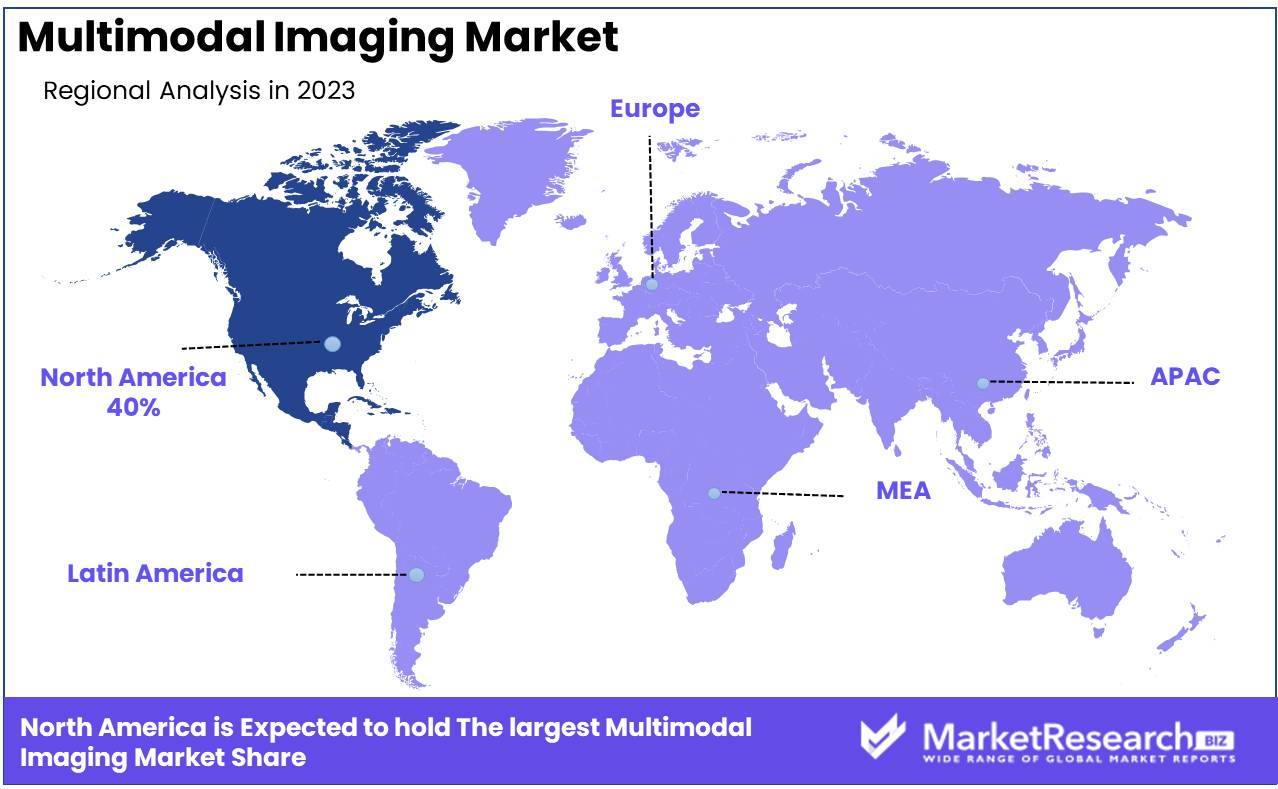
Global Multimodal Imaging Market By Technology (PET/CT, PET/MR, SPECT/CT, OCT/FMT, Other multimodal imaging), By Application (Brain & Neurology, Cardiology, Oncology, Ophthalmology, Research Applications, Other Applications), By End User (Hospitals, Diagnostic Imaging Centers, Research and Academic Institutes, Other End Users), By Region and Companies - Industry Segment Outlook, Market Assessment, Competition Scenario, Trends and Forecast 2024-2033
-
44780
-
April 2024
-
390
-
-
This report was compiled by Trishita Deb Trishita Deb is an experienced market research and consulting professional with over 7 years of expertise across healthcare, consumer goods, and materials, contributing to over 400 healthcare-related reports. Correspondence Team Lead- Healthcare Linkedin | Detailed Market research Methodology Our methodology involves a mix of primary research, including interviews with leading mental health experts, and secondary research from reputable medical journals and databases. View Detailed Methodology Page
-
Quick Navigation
Report Overview
The Global Multimodal Imaging Market was valued at USD 4.5 Bn in 2023. It is expected to reach USD 7.8 Bn by 2033, with a CAGR of 5.8% during the forecast period from 2024 to 2033.
The Multimodal Imaging Market refers to the dynamic landscape within the medical imaging sector, characterized by the integration of various imaging modalities to enhance diagnostic accuracy and clinical decision-making. It encompasses a spectrum of imaging techniques such as MRI, CT, PET, ultrasound, and optical imaging, synergistically combined to offer comprehensive insights into anatomical structures and physiological processes.

Multimodal Imaging Market thrives on innovation, driving advancements in technology and software solutions to address the evolving demands of healthcare providers and improve patient outcomes. With its ability to provide detailed and complementary information, the Multimodal Imaging Market is poised for substantial growth and transformative impact across medical specialties.
The Multimodal Imaging Market stands at a pivotal juncture, poised for significant growth and innovation. This dynamic landscape is shaped by a convergence of technological advancements, increasing demand for precision diagnostics, and evolving healthcare paradigms. As an analyst, it's imperative to delve into the multifaceted factors influencing this market's trajectory.
Supporting this perspective are recent findings shedding light on the prevalence of low-value diagnostic imaging practices globally. A scoping review published in BMC Medical Imaging underscores the pressing need for judicious utilization of imaging modalities, with a substantial portion of radiological examinations deemed as overused. Such insights underscore the significance of multimodal imaging solutions in optimizing diagnostic workflows and minimizing unnecessary procedures, thereby aligning with value-based care initiatives.
The widespread utilization of computer-aided detection (CAD) in mammography further bolsters the market's growth trajectory. With approximately 92% of screening mammograms in the U.S. leveraging CAD in 2016, the integration of AI-driven technologies augments radiologists' capabilities, enabling more accurate and timely detection of breast abnormalities.
Key Takeaways
- Market growth: The Global Multimodal Imaging Market was valued at USD 4.5 Bn in 2023. It is expected to reach USD 7.8 Bn by 2033, with a CAGR of 5.8% during the forecast period from 2024 to 2033.
- By Technology: PET/CT technology holds a commanding 40% share in the multimodal imaging market, reflecting its prominence and adoption across various medical imaging applications
- By Application: In the field of brain and neurology imaging, a significant 25% dominance is observed within the multimodal imaging market, indicating its pivotal role in diagnosing and treating neurological disorders
- By End User: Hospitals emerge as the dominant sector, commanding a substantial 35% share in the multimodal imaging market, highlighting the integral role of this technology in clinical settings and patient care within hospital environments.
- Regional Dominance: North America typically held a substantial share of the global multimodal imaging market, often accounting for around 40% of the market share.
- Growth Opportunity: Multimodal Imaging Market poised for exponential growth, driven by the increasing demand for advanced diagnostic capabilities, with integration of AI and technological advancements. However, regulatory hurdles and high initial investment costs pose significant challenges to market expansion.
Driving factors
Rising Patient Population and Chronic Diseases
The Multimodal Imaging Market experiences significant growth due to the rising prevalence of chronic diseases and an expanding global population. As healthcare infrastructure improves worldwide, more individuals seek diagnostic solutions for ailments such as cancer, cardiovascular diseases, and neurological disorders. These chronic conditions contribute substantially to the global disease burden, with projections indicating a substantial increase by 2030.
Multimodal imaging, which combines modalities like MRI, CT, and PET scans, addresses the diagnostic challenges posed by complex diseases. By offering comprehensive insights into pathologies, healthcare providers rely on these advanced techniques for timely diagnoses and personalized treatment plans. Consequently, the market expands as healthcare facilities increasingly adopt multimodal imaging to meet the diagnostic needs of a growing patient population.
Technological Advancements
Continuous technological innovation drives growth in the Multimodal Imaging Market, enhancing the precision, speed, and versatility of imaging systems. Advancements in imaging modalities, softwa re algorithms, and hardware components improve diagnostic capabilities. For example, integration of artificial intelligence (AI) algorithms streamlines image interpretation, enhancing accuracy and efficiency.
Hardware developments like higher field-strength MRI machines and faster PET scanners improve image resolution and reduce scan times, optimizing patient throughput and diagnostic accuracy. These technological strides not only improve diagnostic capabilities but also drive adoption across medical specialties. As healthcare providers embrace cutting-edge solutions to deliver superior patient care, the demand for multimodal imaging grows, fostering market expansion.
Increasing Adoption of Multimodal Imaging for Diagnostic Imaging
The Multimodal Imaging Market expands as healthcare providers increasingly recognize the clinical benefits of multimodal imaging. By combining modalities like MRI, CT, and PET, multimodal imaging offers a holistic view of anatomical structures and physiological functions, facilitating accurate diagnoses and treatment planning. Its versatility allows for a wide range of applications across specialties like oncology, cardiology, and neurology.
As healthcare systems prioritize value-based care, the demand for multimodal imaging solutions surges. This growing acceptance and integration into clinical practice drive market growth, as healthcare providers leverage these advanced technologies to improve patient outcomes and diagnostic accuracy.
Availability of Reimbursement and Insurance Coverage for Multimodal Imaging Scans
The availability of reimbursement and insurance coverage is crucial for the growth of the Multimodal Imaging Market. Favorable reimbursement policies incentivize healthcare providers to offer multimodal imaging services, ensuring equitable access for patients.
These policies mitigate financial barriers for healthcare facilities seeking to invest in multimodal imaging infrastructure. By aligning financial incentives with adoption, reimbursement frameworks promote market expansion. As a result, multimodal imaging becomes integrated into routine clinical practice, driving sustained growth and innovation in the market.
Restraining Factors
Growing End-User Preference for Refurbished Equipment
In response to the high costs of new multimodal imaging systems, there is a growing trend among healthcare providers to opt for refurbished equipment. This preference stems from the need to contain costs while still benefiting from the capabilities of multimodal imaging.
Refurbished equipment offers a more affordable alternative, allowing healthcare facilities to access advanced imaging modalities without stretching their budgets beyond sustainability.
Data Privacy and Security Concerns
Data privacy and security concerns pose a significant challenge to the adoption of multimodal imaging systems in healthcare settings. These advanced imaging technologies generate vast amounts of sensitive patient data, including medical images and personal health information.
Ensuring the confidentiality, integrity, and availability of this data is paramount to maintaining patient trust and complying with regulatory requirements such as HIPAA. Addressing these concerns requires robust data protection measures and adherence to stringent security standards throughout the imaging workflow.
By Technology Analysis
PET/CT emerged as the dominant technology in the Multimodal Imaging Market, securing over 40% market share.
In 2023, PET/CT held a dominant market position in the Technology segment of the Multimodal Imaging Market, capturing more than a 40% share.This remarkable performance can be attributed to its unparalleled capabilities in combining the anatomical information from computed tomography (CT) scans with the functional data obtained from positron emission tomography (PET) scans. By seamlessly integrating these two imaging modalities, PET/CT offers clinicians and researchers a comprehensive view of both structure and function within the body, facilitating more accurate diagnoses and treatment planning.
Moving on to the PET/MR segment, PET/MR emerged as a promising contender within the multimodal imaging landscape. While it may not have secured the same level of market dominance as PET/CT, PET/MR showcased significant growth potential, driven by its unique ability to provide simultaneous anatomical and functional imaging with excellent soft tissue contrast. This innovative technology has garnered attention for its potential applications in various fields, including oncology, neurology, and cardiology, where precise anatomical and functional information is crucial for clinical decision-making.
In the SPECT/CT segment, SPECT/CT maintained its position as a vital player in the multimodal imaging market. Offering the fusion of single-photon emission computed tomography (SPECT) and CT imaging, SPECT/CT continued to be valued for its ability to combine functional and anatomical information in nuclear medicine applications. Its versatility in imaging a wide range of physiological processes, coupled with enhanced spatial resolution provided by CT, contributed to its steady market presence.
In the OCT/FMT segment, Optical Coherence Tomography (OCT) and Fluorescence Molecular Tomography (FMT) technologies showcased notable advancements and adoption rates. OCT, with its high-resolution, cross-sectional imaging capabilities, found extensive utilization in ophthalmology, cardiology, and dermatology for visualizing tissue microstructure. On the other hand, FMT gained traction for its ability to non-invasively visualize and quantify molecular processes within biological tissues, presenting opportunities for preclinical research and drug development.
By Application Analysis
Brain & Neurology surged ahead in the Multimodal Imaging Market, commanding over 25% market share in the By Application segment, establishing a notable lead over competitors.
In 2023, Brain & Neurology emerged as a frontrunner in the Multimodal Imaging Market, dominating the segment focused on By Application. This sector accounted for over 25% of the market share, signifying a significant lead over its counterparts. The prevalence of Brain & Neurology applications underscores the critical role of multimodal imaging technologies in understanding neurological disorders, brain function, and related research.
The dominance of Brain & Neurology within this segment can be attributed to several factors. Firstly, the increasing incidence of neurological disorders globally has heightened the demand for advanced imaging techniques for accurate diagnosis and monitoring of conditions such as Alzheimer's disease, Parkinson's disease, and multiple sclerosis. Multimodal imaging offers a comprehensive approach, combining various modalities such as magnetic resonance imaging (MRI), positron emission tomography (PET), and computed tomography (CT) for a more detailed assessment of neurological conditions.
Ongoing research and development initiatives have led to innovations in multimodal imaging technologies specifically tailored for brain and neurology applications. These advancements have enhanced the sensitivity, resolution, and specificity of imaging modalities, enabling clinicians and researchers to detect subtle neurological changes and abnormalities with greater precision.
Growing adoption of multimodal imaging in neurosurgical planning and intraoperative guidance has contributed to the market dominance of Brain & Neurology in the By Application segment. Integrating multiple imaging modalities allows surgeons to visualize critical structures, plan surgical approaches, and navigate complex neurosurgical procedures with improved accuracy and safety.
The Brain & Neurology segment is poised for continued growth, driven by ongoing technological advancements, increasing research investments, and the rising prevalence of neurological disorders worldwide. As the demand for precise diagnostic and therapeutic solutions for neurological conditions continues to escalate, Brain & Neurology is expected to maintain its dominant position in the Multimodal Imaging Market, shaping the future of neuroimaging and neuroscience research.

By End User Analysis
Hospitals dominated the By End User segment of the Multimodal Imaging Market, securing over 35% market share.
In 2023, Hospitals held a dominant market position in the By End User segment of the Multimodal Imaging Market, capturing more than a 35% share. Hospitals, being primary healthcare providers, have substantial infrastructure and resources to invest in advanced imaging technologies. This includes MRI, CT scans, and PET scans, among others, enabling comprehensive diagnostic capabilities. With a focus on patient care and diagnosis, hospitals prioritize the integration of multimodal imaging solutions to enhance diagnostic accuracy and efficiency.
Diagnostic Imaging Centers also played a significant role in the Multimodal Imaging Market, albeit with a slightly lower market share compared to hospitals. These centers specialize in imaging services, offering a wide range of diagnostic procedures to patients referred by healthcare providers. Diagnostic imaging centers often invest in state-of-the-art imaging equipment to provide accurate and timely diagnostic services, catering to the growing demand for advanced imaging technologies.
Research and Academic Institutes emerged as another key player in the Multimodal Imaging Market segment. These institutions conduct extensive research in medical imaging technologies, driving innovation and advancements in multimodal imaging systems. With a focus on both clinical and academic research, these institutes contribute to the development of cutting-edge imaging techniques and applications, shaping the future landscape of multimodal imaging technologies.
Other End Users, comprising various healthcare facilities such as ambulatory surgical centers, specialty clinics, and outpatient care centers, also contributed to the Multimodal Imaging Market segment. While individually accounting for smaller market shares, these end users collectively play a significant role in expanding the adoption of multimodal imaging technologies across diverse healthcare settings
Key Market Segments
By Technology
- PET/CT
- PET/MR
- SPECT/CT
- OCT/FMT
- Other multimodal imaging
By Application
- Brain & Neurology
- Cardiology
- Oncology
- Ophthalmology
- Research Applications
- Other Applications
By End User
- Hospitals
- Diagnostic Imaging Centers
- Research and Academic Institutes
- Other End Users
Growth Opportunity
Growing Application Spectrum
The year 2024 presents a landscape ripe with diverse applications for multimodal imaging systems. From healthcare to automotive, and from aerospace to electronics, industries are increasingly leveraging the power of combined imaging modalities. This widespread adoption is fueled by the pressing need for comprehensive and precise insights across various domains.
Multimodal imaging, a revolutionary approach combining multiple imaging techniques, is poised for significant growth in 2024. This convergence of technologies offers immense potential across various sectors, promising enhanced insights and improved outcomes. Let's delve into the key opportunities shaping the global multimodal imaging market.
Enhanced Safety and Quality Control
Furthermore, the integration of multimodal imaging brings forth improved safety and quality control measures in manufacturing and industrial applications. By facilitating enhanced defect detection and quality assurance processes, these systems ensure product integrity and regulatory compliance while optimizing operational efficiency.
The growing application of multimodal imaging systems is evident in the healthcare sector's pursuit of more accurate diagnostics and personalized treatment plans. Additionally, industries such as automotive and aerospace are turning to multimodal imaging for streamlined quality control and defect detection in manufacturing processes. This broadening scope underscores the market's potential to cater to a multitude of needs across industries.
Latest Trends
Advancements in Imaging Technologies
The landscape of multimodal imaging is rapidly evolving with groundbreaking advancements in imaging technologies. Innovations such as artificial intelligence (AI) integration, improved resolution, and enhanced contrast agents are reshaping the capabilities of multimodal imaging systems. These advancements enable more accurate and detailed imaging, facilitating better diagnosis and treatment planning across various medical disciplines.
Increasing Demand for Early Diagnosis & Treatment
As healthcare systems worldwide emphasize preventive care and early intervention, the demand for multimodal imaging for early diagnosis and treatment is on the rise. Patients and healthcare providers alike recognize the value of detecting diseases at their nascent stages when interventions are most effective. Multimodal imaging techniques offer a comprehensive approach, allowing clinicians to detect subtle abnormalities and initiate timely interventions, thereby improving patient outcomes and reducing healthcare costs associated with advanced disease management.
There is a growing awareness among the general population about the critical role of early diagnosis and treatment in mitigating the burden of diseases. Increased health literacy, coupled with educational campaigns and advocacy efforts, has led to a heightened understanding of the importance of proactive healthcare measures. Multimodal imaging, with its ability to provide comprehensive insights into various physiological processes, is becoming increasingly instrumental in facilitating early diagnosis, fostering a paradigm shift towards preventive healthcare strategies.
Regional Analysis
In North America, the market segment shows robust growth, capturing a significant share of the global market at approximately 40%. This dominance can be attributed to several factors including technological advancements, high disposable income, and a strong presence of key market players. Additionally, increasing consumer awareness regarding health and wellness products, coupled with a growing trend towards organic and natural ingredients, further fuels the segment's expansion in this region.
Europe represents another substantial market segment for the industry, accounting for a considerable portion of the global market share. The segment's growth in Europe is propelled by factors such as increasing urbanization, rising health consciousness among consumers, and stringent regulatory frameworks promoting product quality and safety. Countries like Germany, France, and the United Kingdom emerge as key contributors to the market's expansion in this region, with a notable preference for sustainable and eco-friendly products.
The Asia Pacific region emerges as a lucrative market segment, exhibiting rapid growth propelled by factors such as a burgeoning population, rising disposable incomes, and changing consumer lifestyles. Countries like China, Japan, and India lead the market expansion, driven by increasing urbanization, a growing middle-class population, and a heightened focus on personal grooming and wellness. Furthermore, the adoption of e-commerce platforms and digital marketing strategies plays a pivotal role in augmenting market penetration across diverse demographics in this region.
The market segment in the Middle East & Africa region demonstrates steady growth, albeit at a relatively slower pace compared to other regions. Countries like the United Arab Emirates, Saudi Arabia, and South Africa emerge as key markets within the region, driven by a growing demand for premium skincare and beauty products, influenced by cultural preferences and international trends.
Latin America represents a burgeoning market segment characterized by a growing consumer base and evolving beauty trends. The region showcases promising growth prospects fueled by factors such as a rising middle-class population, urbanization, and increasing expenditure on personal care products. Brazil, Mexico, and Argentina stand out as key contributors to market expansion, driven by a cultural emphasis on beauty and wellness, alongside a growing affinity towards natural and organic skincare solutions. Additionally, strategic partnerships between local and international beauty brands contribute to market diversification and product innovation in the region.

Key Regions and Countries
North America
- The US
- Canada
- Rest of North America
Europe
- Germany
- France
- The UK
- Spain
- Netherlands
- Russia
- Italy
- Rest of Europe
Asia-Pacific
- China
- Japan
- Singapore
- Thailand
- South Korea
- Vietnam
- India
- New Zealand
- Rest of Asia Pacific
Latin America
- Mexico
- Brazil
- Rest of Latin America
Middle East & Africa
- Saudi Arabia
- South Africa
- UAE
- Rest of Middle East & Africa
Key Players Analysis
As of 2024, the global Multimodal Imaging Market is witnessing dynamic growth with several key players making significant strides in innovation and market penetration. Among these players, Neusoft Corporation stands out as a prominent contender. With its diverse portfolio of imaging solutions and a focus on research and development, Neusoft Corporation has positioned itself as a leader in the multimodal imaging sector. The company's commitment to advancing imaging technology, coupled with its strong global presence, makes it a formidable competitor in the market.
Koninklijke Philips N.V., another major player, brings to the table its extensive experience and expertise in healthcare technology. With a wide range of multimodal imaging solutions catering to various medical specialties, Philips continues to be a trusted choice for healthcare providers worldwide.
GE Healthcare, a stalwart in the healthcare industry, maintains its stronghold in the multimodal imaging market with innovative products and strategic partnerships. Spectrum Dynamics Medical LLC, Siemens, Canon Inc., Topcon Corporation, Mediso Ltd., MR Solutions, and Bruker Corporation round out the key players shaping the landscape of multimodal imaging.
In this competitive environment, differentiation through technological advancements, product reliability, and customer service will be crucial for sustaining growth and gaining a competitive edge. Additionally, with the increasing emphasis on personalized medicine and precision diagnostics, companies that can offer integrated multimodal imaging solutions tailored to specific patient needs are likely to thrive.
Market Key Players
- Neusoft Corporation
- Koninklijke Philips N.V.
- GE Healthcare
- Spectrum Dynamics Medical
- LLC
- Siemens
- Canon Inc.
- Topcon Corporation
- Mediso Ltd.
- MR Solutions
- Bruker Corporation
Recent Developement
- In Apr 2024, Velsera, Flywheel, and D3b partnered to integrate genomic and medical imaging data, enhancing precision medicine via NIH's INCLUDE Project. Interoperability standards enable efficient data access and analysis in cloud-based platforms.
- In February 2024, Champagne vineyard developed a non-destructive method for diagnosing grapevine trunk diseases using multimodal 3D imaging and AI. The approach accurately distinguishes healthy and degraded tissues, aiding vineyard sustainability.
- In November 2023, CT technology include Philips' AI-powered CT 3500 for high-volume radiology, and NeuroLogica's BodyTom 64 Point-of-Care Mobile CT Scanner for trauma imaging, enhancing efficiency and accessibility.
- In November 2023, NP@MOF nanostructures for targeted drug delivery and imaging-guided tumor treatment. Notably, researchers at the organization have made significant strides in enhancing therapeutic efficacy through synergistic combination therapy.
Report Scope
Report Features Description Market Value (2023) USD 4.5 Bn Forecast Revenue (2033) USD 7.8 Bn CAGR (2024-2032) 5.8% Base Year for Estimation 2023 Historic Period 2016-2023 Forecast Period 2024-2033 Report Coverage Revenue Forecast, Market Dynamics, COVID-19 Impact, Competitive Landscape, Recent Developments Segments Covered By Technology (PET/CT, PET/MR, SPECT/CT, OCT/FMT, Other multimodal imaging), By Application (Brain & Neurology, Cardiology, Oncology, Ophthalmology, Research Applications, Other Applications), By End User (Hospitals, Diagnostic Imaging Centers, Research and Academic Institutes, Other End Users) Regional Analysis North America - The US, Canada, Rest of North America, Europe - Germany, France, The UK, Spain, Italy, Russia, Netherlands, Rest of Europe, Asia-Pacific - China, Japan, South Korea, India, New Zealand, Singapore, Thailand, Vietnam, Rest of Asia Pacific, Latin America - Brazil, Mexico, Rest of Latin America, Middle East & Africa - South Africa, Saudi Arabia, UAE, Rest of Middle East & Africa Competitive Landscape Neusoft Corporation, Koninklijke Philips N.V., GE Healthcare, Spectrum Dynamics Medical, LLC, Siemens, Canon Inc., Topcon Corporation, Mediso Ltd., MR Solutions, Bruker Corporation Customization Scope Customization for segments, region/country-level will be provided. Moreover, additional customization can be done based on the requirements. Purchase Options We have three licenses to opt for Single User License, Multi-User License (Up to 5 Users), Corporate Use License (Unlimited User and Printable PDF) -
-
- Neusoft Corporation
- Koninklijke Philips N.V.
- GE Healthcare
- Spectrum Dynamics Medical
- LLC
- Siemens
- Canon Inc.
- Topcon Corporation
- Mediso Ltd.
- MR Solutions
- Bruker Corporation




